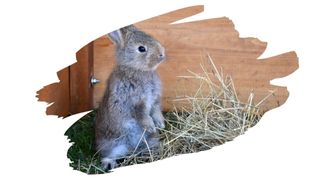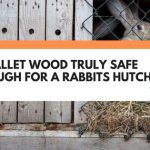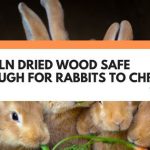Rabbit hutches should be dry, warm, and most importantly, safe places for your pet to live in. And, when it comes to wooden hutches, it would be nice if they were durable too.
But, some of the chemicals used to treat and preserve wood can be too toxic to have near your rabbits. So, what can you treat wood with instead?
Well, in this post, we dive into why treated wood is a complete no-no for making a rabbits hutch with. You’ll also learn why even ‘farm-animal-safe’ green treated wood can be too risky to use around chew-happy pets.
And keep reading to discover which odorless wood preservative is your best option for treating an outdoor hutch.

This post may contain affiliate links to products that we receive a commission for (at no additional cost to you). Learn more here.
What Types Of Wood Are Safe to Use For A Rabbits Hutch?
The safest type of wood will almost always be natural kiln-dried solid wood.
Natural solid wood does not have any chemical treatments added to it. And, after wood has been kiln-dried, it doesn’t contain any tree sap/pitch in that lumber either.
When it comes to specific tree species, generally fruit tree lumber such as Apple wood, are safe for rabbits.
Now, full disclosure, Apple wood is not the most rot-resistant hardwood you can work with. Nevertheless, it is still one of the safest ones you can have around your rabbits.
Related Post: Want To Use Apple Wood For Woodworking? 3 Things To Know
Why Does The Wood Need To Be Kiln Dried?
Well, kiln dried wood will have been put through a heat process that involves drying it in a kiln oven.
This high-heated environment will evaporate all the moisture content inside lumber. What’s more, it’ll also evaporate the tree sap in it as well.
Tree sap is the thick resinous substance that trees secrete to help fight off bug attacks. And, if a rabbits chews on timber that’s still saturated with sap, they can become ill.
This is why sap-saturated timbers, (such as Fir), are unsafe woods to have around rabbits.
Related Post: What’s The Difference Between Douglas Fir Vs Whitewood?
And What Is The Safest Type Of Wood Finish For A Rabbits Hutch?
To be perfectly honest, the safest type of finish would be to use no type of wood finish at all. There aren’t any durable exterior wood finishes that are also wholly natural.
For example, wood finishes such as Teak oil or Boiled Linseed oil, contain solvents and mineral spirits. And even natural oil finishes, like Tung oil, aren’t something you’d want your rabbits to accidentally ingest.
On top of that, you also need to take into account whether your rabbits hutch will be outdoors or indoors. Outdoor hutches will need more than just a coat of wood finish to protect them from moisture and humidity.
Instead, exterior wooden structures will often need to be treated with wood preservatives to help prevent wood rot.
Related Post: Is Pallet Wood Truly Safe Enough For A Rabbits Hutch?
What Is Treated Wood Exactly?
Treated wood is any lumber that’s been put through a pressure treatment process. This involves infusing wood with wood preserving chemicals.
Those chemicals act like a fungicide, since their job is to fight off the bacteria responsible for wood rot.
Untreated nondurable woods — if they become damp — can quickly rot away. But, treated wood will last much longer, especially in outdoor conditions.
So Is Treated Wood Safe For Rabbits?
The chemicals used in these wood preserving treatments is often very toxic — certainly much too toxic for rabbits to be around.
For example, some types of treatments can contain Chromated copper arsenate (CCA), which contains arsenic. Having said that, these particularly toxic wood treatments, have been banned from being used on wood meant for residential properties.
Related Post: Is Plywood Safe Enough To Use For A Rabbits Hutch?
Are There Any Safe Treated Timbers Out There?
There is a much safer type of treated wood called ‘green-treated’ wood. Green-treated wood is safer because it contains water-soluble chemicals that are safe around humans and farm animals.
For example, one popular green treated wood preservative is Alkaline Copper Quaternary (ACQ). This wood preservative contains Copper Oxide.
Copper oxide, (also referred to as Cupric Oxide), can be found in some multivitamin products.
ACQ’s copper content is also the reason why this green treated wood has a green colored hue to it. This is because the copper in it reacts with the oxygen in the air (known as oxidizing).
In fact, ACQ green treated wood is the most low-risk treated wood you can use. And that’s why the E.P.A. (U.S. Environmental Protection Agency), have approved it’s use around your garden.
So, Is Green Treated Wood Safe To Have Around My Rabbits?
Well, the safety of treated wood is relative. ACQ treated wood is much, much safer than CCA treated timber. But, you still wouldn’t want to risk using it around animals that specifically like to chew on wood.
So, when it comes to rabbits in particular, then no, using green treated wood is not worth the risk.
OK. So How Do You Safely Treat The Wood Of A Hutch To Prevent It From Decaying?
You should continue to only use untreated natural solid wood. And simply avoid treated wood altogether.
Instead, coat your pet’s wooden home with a pet-safe wood preservative yourself.
Now ideally, that wood preservative should be designed for exterior use (especially for an outdoor hutch). Which is why you should get your hands on some of Cuprinol’s Clear Wood Preserver.
Cuprinol’s odorless clear preservative is safe enough to be coated onto any pet’s home — from birdhouses to rabbit hutches.
It’s incredibly easy to apply, as it will sink right down into wooden surfaces, protecting it from the inside out.
You can learn more about Cuprinol Wood Preserver over on Cuprinol’s official website right here.
It’s also worth noting here that this is a base coat product. Which means it’ll need a top coat over it to finish things off.
In other words, you will need to apply a coat of paint or wood sealer over it.
You can learn more about pet-safe paints by checking out our post right here: Is There A Bird Safe Paint For Wood? (+ Why VOC’s Are The Real Problem)
To Wrap Up, Here Are The 3 Key Takeaways From This Post…
- 1). Do not use treated wood to make a rabbits hutch. Treated wood will have often been infused with toxic chemicals that are too dangerous to have near your pet.
- 2). You should only use untreated natural solid wood to make a hutch from.
- 3). However, in order to protect that hutch from decay, coat it with a pet-safe wood preservative base coat.
References:
Treated Wood In The Landscape | Home & Garden Information Center
Enhancing your rabbit’s diet | RSPCA.org.uk



